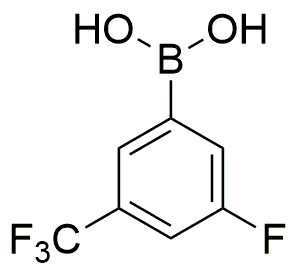3-Fluoro-5-(trifluoromethyl)phenylboronic acid is widely utilized in research focused on:
- Pharmaceutical Development: This compound plays a crucial role in the synthesis of various pharmaceuticals, particularly in creating targeted therapies for cancer treatment, due to its ability to form stable complexes with biological targets.
- Organic Synthesis: It is a valuable reagent in organic chemistry for cross-coupling reactions, enabling the formation of carbon-carbon bonds, which is essential in the production of complex organic molecules.
- Material Science: The compound is used in developing advanced materials, including polymers and coatings, that require specific electronic or optical properties, enhancing performance in various applications.
- Fluorinated Compounds: Its unique fluorine substituents make it a key building block in synthesizing fluorinated compounds, which are important in agrochemicals and specialty chemicals, providing enhanced stability and reactivity.
- Analytical Chemistry: This boronic acid derivative is employed in analytical methods for detecting and quantifying sugars and other biomolecules, offering high sensitivity and specificity in various assays.
General Information
Properties
Safety and Regulations
Applications
3-Fluoro-5-(trifluoromethyl)phenylboronic acid is widely utilized in research focused on:
- Pharmaceutical Development: This compound plays a crucial role in the synthesis of various pharmaceuticals, particularly in creating targeted therapies for cancer treatment, due to its ability to form stable complexes with biological targets.
- Organic Synthesis: It is a valuable reagent in organic chemistry for cross-coupling reactions, enabling the formation of carbon-carbon bonds, which is essential in the production of complex organic molecules.
- Material Science: The compound is used in developing advanced materials, including polymers and coatings, that require specific electronic or optical properties, enhancing performance in various applications.
- Fluorinated Compounds: Its unique fluorine substituents make it a key building block in synthesizing fluorinated compounds, which are important in agrochemicals and specialty chemicals, providing enhanced stability and reactivity.
- Analytical Chemistry: This boronic acid derivative is employed in analytical methods for detecting and quantifying sugars and other biomolecules, offering high sensitivity and specificity in various assays.
Documents
Safety Data Sheets (SDS)
The SDS provides comprehensive safety information on handling, storage, and disposal of the product.
Product Specification (PS)
The PS provides a comprehensive breakdown of the product’s properties, including chemical composition, physical state, purity, and storage requirements. It also details acceptable quality ranges and the product's intended applications.
Certificates of Analysis (COA)
Search for Certificates of Analysis (COA) by entering the products Lot Number. Lot and Batch Numbers can be found on a product’s label following the words ‘Lot’ or ‘Batch’.
*Catalog Number
*Lot Number
Certificates Of Origin (COO)
This COO confirms the country where the product was manufactured, and also details the materials and components used in it and whether it is derived from natural, synthetic, or other specific sources. This certificate may be required for customs, trade, and regulatory compliance.
*Catalog Number
*Lot Number
Safety Data Sheets (SDS)
The SDS provides comprehensive safety information on handling, storage, and disposal of the product.
DownloadProduct Specification (PS)
The PS provides a comprehensive breakdown of the product’s properties, including chemical composition, physical state, purity, and storage requirements. It also details acceptable quality ranges and the product's intended applications.
DownloadCertificates of Analysis (COA)
Search for Certificates of Analysis (COA) by entering the products Lot Number. Lot and Batch Numbers can be found on a product’s label following the words ‘Lot’ or ‘Batch’.
*Catalog Number
*Lot Number
Certificates Of Origin (COO)
This COO confirms the country where the product was manufactured, and also details the materials and components used in it and whether it is derived from natural, synthetic, or other specific sources. This certificate may be required for customs, trade, and regulatory compliance.


